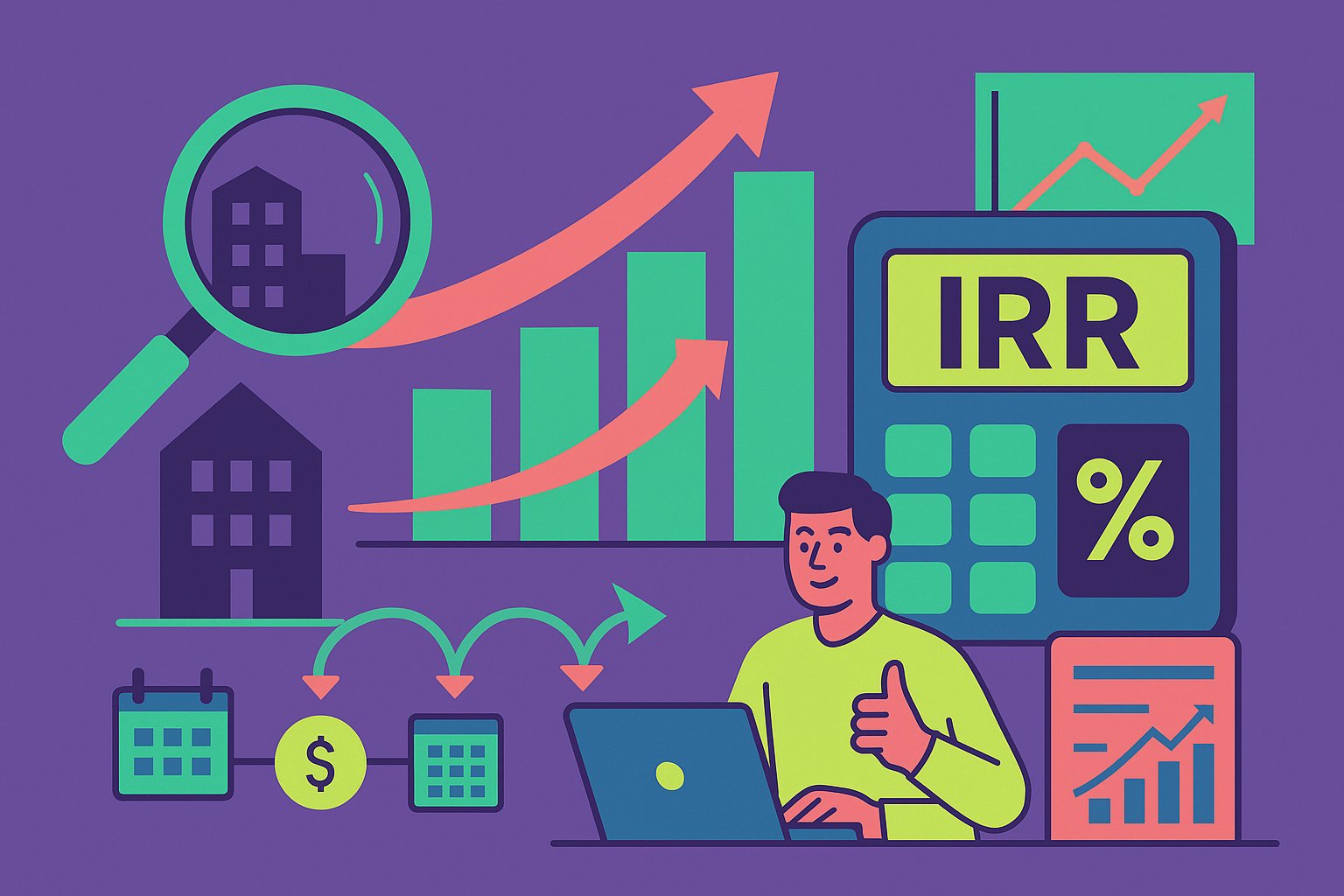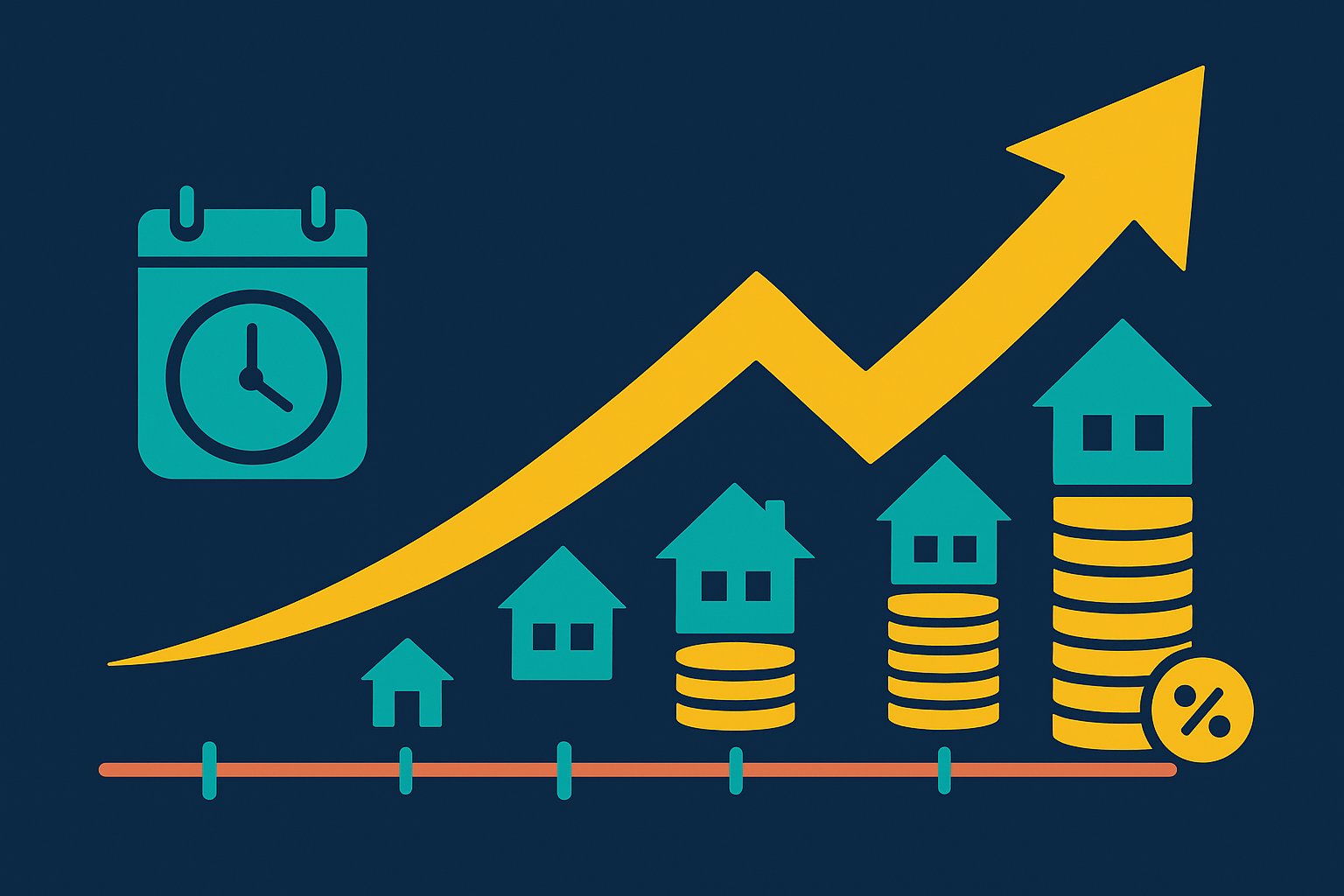Unlocking the Power of IRR in Real Estate Crowdfunding
When you back a real estate crowdfunding project, you entrust your capital to a sponsor’s vision of property acquisition, development, or redevelopment. But how do you compare deals on an equal footing, knowing some distribute cash quickly while others hold out for appreciation and sale proceeds? The answer lies in mastering the Internal Rate of Return (IRR)—the cornerstone metric for evaluating the time value of money across multiple cash flows. This article guides you through IRR’s fundamentals, its nuances in crowdfunding contexts, and advanced strategies to harness IRR calculations for sharper investment decisions.
Demystifying IRR: The Financial Compass
At its essence, IRR represents the annualized discount rate that equates the present value of all future cash inflows and outflows to zero. In practical terms, it tells you the yield you’re likely to earn on your invested capital if the project unfolds exactly as projected. Unlike a simple average return or cash-on-cash yield, IRR captures both the timing and scale of distributions—whether you receive a quarterly dividend or a lump-sum payout at exit. For real estate crowdfunding, where cash flows often vary widely depending on hold periods, refinance events, or sponsor promote structures, IRR becomes an indispensable compass guiding capital toward the most efficient use of funds.
Calculating IRR: From Cash Flows to Rate
The IRR calculation begins with mapping a project’s expected cash flow timeline. At time zero, your initial investment is recorded as a negative value. Subsequent periods list positive cash flows—quarterly interest payments, preferred dividends, or net sale proceeds. The IRR is the rate “r” that solves the equation where the sum of each cash flow divided by (1 + r) to the power of its period equals zero. While financial calculators and spreadsheet functions like Excel’s =IRR() automate this iterative process, understanding its conceptual underpinnings empowers you to interpret results critically. You’ll recognize that small shifts in early cash flows or exit timing can cause notable IRR swings, highlighting the sensitivity of this metric to cash flow distribution patterns.
Why IRR Matters in Crowdfunding Scenarios
Real estate crowdfunding deals vary widely: some platforms specialize in short-term bridge loans paying fixed interest; others syndicate equity stakes in development projects with longer horizons and promote waterfalls. IRR provides a common yardstick across these structures, balancing the allure of high project-level yields against the biologically simple question of “When will I get my money back?” By converting diverse cash flow schedules into a single annualized rate, IRR lets you compare a six-month bridge loan at 8 percent straight-line interest to a three-year equity play targeting a 20 percent IRR—and decide which aligns best with your objectives and liquidity needs.
Comparing IRR to Other Metrics: The Broader Toolbox
While IRR is powerful, it doesn’t stand alone. The cash-on-cash multiple (equity multiple) measures total return relative to capital invested, ignoring time value. Net Present Value (NPV) yields the dollar value added at a chosen discount rate. Modified IRR (MIRR) adjusts for reinvestment assumptions, potentially offering a more realistic picture if early distributions can’t be reinvested at the same rate. In real estate crowdfunding, blending these metrics strengthens your analysis: IRR highlights efficiency, equity multiple quantifies total upside, and NPV underscores value creation at your required hurdle. Armed with this toolkit, you can tailor deal selection to whether you prioritize swift capital recycling, maximum aggregate gains, or a balance of both.
Building Your IRR Model: Step by Step
Constructing an IRR model begins with gathering deal documents—subscription agreements, offering memoranda, and pro forma statements. Extract the timeline of anticipated distributions: loan interest payments or preferred dividends by quarter or year, followed by maturity lump sums. Input these cash flow values into a spreadsheet, ensuring uniform periodicity and correctly labeling the initial outflow. Use the built-in IRR function, double-checking that cash flow signs (positive versus negative) are accurate. Then experiment: adjust cash flows to simulate early exits, missed distributions, or extension fees. By stress-testing your IRR model against upside and downside scenarios, you gain a richer understanding of deal robustness and the key sensitivities driving returns.
Incorporating Sponsor Promote and Waterfalls into IRR
Equity deals often feature sponsor promotes—a percentage of profits above a hurdle rate—structured through distribution waterfalls. For example, common equity investors might receive all cash flows up to an 8 percent IRR, after which profits split 70/30 in favor of the sponsor until a 15 percent IRR is reached, and then 50/50 thereafter. Accurately modeling these tiers is critical. Build detailed waterfalls in your cash flow schedule, allocating sponsor promote deductions at the appropriate hurdle points. The resulting IRR calculation then reflects your true net yield, accounting for the sponsor’s share. This precision prevents overestimating returns and ensures you compare deals on an apples-to-apples, after-promote basis.
Timing and Reinvestment Assumptions: The Hidden Variables
One critique of IRR is its implicit assumption that interim cash inflows can be reinvested at the same rate—an often unrealistic premise. Crowdfunding investors may face limited options to redeploy early distributions at equivalent yields. Enter the Modified IRR (MIRR), which allows you to specify a reinvestment rate distinct from the project’s IRR, producing a more conservative—and often more accurate—performance estimate. When evaluating deals with substantial early dividends or interest payments, calculate both IRR and MIRR. The gap between them signals how critical reinvestment assumptions are to achieving target yields and helps you budget for realistic redeployment strategies.
Evaluating Multiple Deals: Ranking by IRR in Portfolios
With dozens of crowdfunding opportunities available simultaneously, ranking deals by projected IRR streamlines portfolio allocation decisions. However, blanket sorting on headline IRR alone can be misleading if it overlooks risk factors, hold periods, or sponsor quality. Pair your IRR ranking with qualitative assessments: sponsor track record, market fundamentals, and deal complexity. Consider grouping deals by thematic categories—short-term debt, preferred equity, and common equity—to ensure you compare within buckets of similar risk profiles. Then allocate capital to your highest-conviction IRR deals while maintaining target diversification across structure types and markets.
Stress-Testing IRR: Worst-Case and Best-Case Scenarios
Real market outcomes rarely conform perfectly to pro forma projections. By stress-testing your IRR model under conservative assumptions, you reveal the deal’s resilience. Reduce projected NOI by 10 percent, extend the sale date by six months, or increase interest reserves required, and recalculate IRR. If the metric remains above your hurdle rate, the deal can withstand moderate headwinds. Conversely, best-case scenario modeling—such as higher-than-forecasted rent growth or accelerated exit timelines—highlights upside potential, guiding decisions on whether to overweight or underweight the opportunity in your portfolio.
Real-World Case Study: IRR Analysis in Action
Consider a three-year multifamily equity deal targeting a 14 percent IRR. Its pro forma shows quarterly preferred dividends of 2 percent, followed by sale proceeds distributed through a waterfall with sponsor promotes. Input the cash flows: each quarter’s dividends followed by net sale proceeds in Year 3, minus the sponsor’s promote share calculated at each hurdle. The IRR function in your spreadsheet returns 13.8 percent—slightly below the target, due to assumed transaction costs. Next, calculate MIRR using a 6 percent reinvestment rate for dividends, yielding 12.5 percent. Stress-test by reducing rent by 5 percent and delaying sale by two quarters; the IRR dips to 11 percent. These insights inform whether you proceed or negotiate terms.
Advanced Techniques: Multiproject IRR Aggregation
Seasoned crowdfunding investors often juggle multiple simultaneous deals. Aggregating IRRs across projects isn’t as simple as averaging percentages. Instead, calculate a pooled IRR by combining all cash flows—aggregate outflows at various start dates and inflows across periods—into one unified model. This holistic IRR reflects your entire portfolio’s performance trajectory and reveals whether portfolio-level diversification is delivering on risk-adjusted return objectives. Pooled IRR also flags timing mismatches: if one project returns capital early while another locks up funds, your turned-over capital faces redeployment challenges, affecting overall yield.
Pitfalls to Avoid: Common IRR Missteps
While IRR is invaluable, misuse can misguide decisions. Watch out for treating projected sponsor fees or acquisition costs as outside the cash flow schedule, which artificially inflates IRR. Beware of comparing IRRs from deals with wildly different hold periods—such as a one-year bridge loan versus a five-year common equity syndication—without accounting for duration risk. Be cautious of overreliance on IRR when equity multiples are modest; a 15 percent IRR on a deal returning only 1.2x your capital is less attractive than a 10 percent IRR on a deal yielding 2x. Integrating IRR with other metrics safeguards against these traps.
Software Tools and Automation for IRR Mastery
Beyond spreadsheets, specialized investment platforms and portfolio management software can automate IRR calculations, waterfall modeling, and pooled IRR aggregation. These tools pull deal documents, extract cash flow schedules, and run scenario analyses at the click of a button. Some offer real-time dashboards that update IRR projections as actual distributions arrive, immediately recalibrating your expected yield. While software accelerates analysis, it’s essential to understand the underlying calculations—only then can you identify data errors or misconfigurations that might skew results.
Crafting Your IRR-Driven Investment Strategy
Armed with IRR fluency, you can develop a disciplined deal selection process. Define minimum IRR thresholds for each investment category—debt, preferred, and common equity—reflecting your risk tolerance and market outlook. Use IRR as an initial screen, then layer in qualitative factors: sponsor reputation, market momentum, and structural safeguards. Maintain a deal pipeline where capital is deployed to top-ranked IRR opportunities while reserve capital awaits underperforming scenarios. Periodically recalibrate your thresholds based on realized IRRs to ensure your hurdles stay ambitious yet achievable in changing market climates.
The Future of IRR in Crowdfunding: Emerging Trends
As real estate crowdfunding evolves, expect refinements in IRR modeling. Platforms may integrate blockchain-based escrow and distribution records, enabling instantaneous IRR updates as cash flows are executed. Machine learning algorithms could predict IRR sensitivities based on deal attributes and historical sponsor performance. Tokenized assets may trade in secondary markets, allowing real-time price discovery that feeds back into updated IRR calculations. Staying ahead of these trends will give you a competitive edge, transforming IRR from a static projection into a dynamic tool for portfolio optimization.
Turning IRR Insight into Investment Mastery
Mastering IRR calculations is more than a technical exercise—it’s the gateway to informed, disciplined real estate crowdfunding investing. By understanding IRR’s mechanics, stress-testing projections, accounting for waterfalls and reinvestment assumptions, and integrating IRR with complementary metrics, you craft a robust decision-making framework. As you navigate an expanding universe of crowdfunding deals, IRR becomes your North Star, illuminating the path toward the most efficient and rewarding capital allocations. Embrace these principles, refine your models, and watch your crowdfunding portfolio thrive on the solid foundation of IRR-driven insight.




